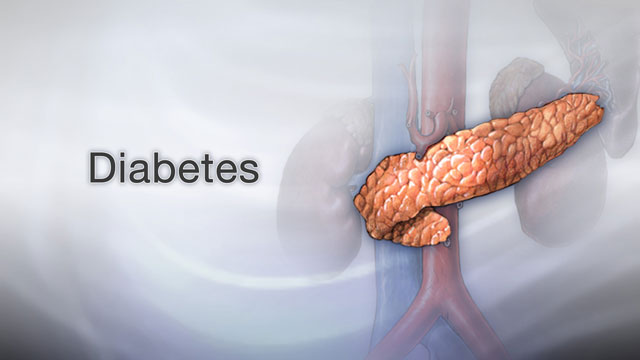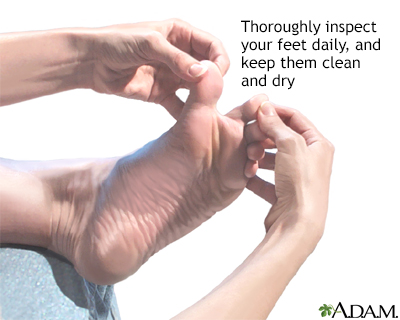Diabetes - taking care of your feet
Diabetes can damage the nerves and blood vessels in your feet. This damage can cause numbness and reduce feeling in your feet. As a result, your feet are more likely to become injured and may not heal well if they are injured. If you get a blister, you may not notice and it may get worse. Even small sores or blisters can become big problems if infection develops or they don't heal. A diabetic foot ulcer can result. Foot ulcers are a common reason for hospital stays for people with diabetes. Taking good care of your feet can help prevent diabetic foot ulcers. Untreated foot ulcers are the most common reason for toe, foot, and leg amputations in people with diabetes.
Diabetes
Diabetes is a long-term (chronic) disease in which the body cannot regulate the amount of sugar in the blood.

Diabetic foot ulcer
If you have diabetes, you have an increased chance of developing foot sores, or ulcers, also called diabetic ulcers. Foot ulcers are a common reason ...

Diabetes - Animation
Diabetes is on the rise worldwide, and is a serious, lifelong disease that can lead to heart disease, stroke, and lasting nerve, eye and foot problems. Let's talk about diabetes and the difference between the three types of diabetes. So, what exactly is diabetes and where does it come from? An organ in your body called the pancreas produces insulin, a hormone that controls the levels of your blood sugar. When you have too little insulin in your body, or when insulin doesn't work right in your body, you can have diabetes, the condition where you have abnormally high glucose or sugar levels in your blood. Normally when you eat food, glucose enters your bloodstream. Glucose is your body's source of fuel. Your pancreas makes insulin to move glucose from your bloodstream into muscle, fat, and liver cells, where your body turns it into energy. People with diabetes have too much blood sugar because their body cannot move glucose into fat, liver, and muscle cells to be changed into and stored for energy. There are three major types of diabetes. Type 1 diabetes happens when the body makes little or no insulin. It usually is diagnosed in children, teens, or young adults. But about 80% of people with diabetes have what's called Type 2 diabetes. This disease often occurs in middle adulthood, but young adults, teens, and now even children are now being diagnosed with it linked to high obesity rates. In Type 2 diabetes, your fat, liver, and muscle cells do not respond to insulin appropriately. Another type of diabetes is called gestational diabetes. It's when high blood sugar develops during pregnancy in a woman who had not had diabetes beforehand. Gestational diabetes usually goes away after the baby is born. But, still pay attention. These women are at a higher risk of type 2 diabetes over the next 5 years without a change in lifestyle. If you doctor suspects you have diabetes, you will probably have a hemoglobin A1c test. This is an average of your blood sugar levels over 3 months. You have pre-diabetes if your A1c is 5.7% to 6.4%. Anything at 6.5% or higher indicates you have diabetes. Type 2 diabetes is a wake up call to focus on diet and exercise to try to control your blood sugar and prevent problems. If you do not control your blood sugar, you could develop eye problems, have problems with sores and infections in your feet, have high blood pressure and cholesterol problems, and have kidney, heart, and problems with other essential organs. People with Type 1 diabetes need to take insulin every day, usually injected under the skin using a needle. Some people may be able to use a pump that delivers insulin to their body all the time. People with Type 2 diabetes may be able to manage their blood sugar through diet and exercise. But if not, they will need to take one or more drugs to lower their blood sugar levels. The good news is, people with any type of diabetes, who maintain good control over their blood sugar, cholesterol, and blood pressure, have a lower risk of kidney disease, eye disease, nervous system problems, heart attack, and stroke, and can live, a long and healthy life.
Self-care
Follow your health care provider's instructions on how to take care of your feet. Use the information below as a reminder.
Diabetes is a long-term (chronic) disease in which the body cannot regulate the amount of sugar in the blood.

Check your feet every day. Inspect the tops, sides, soles, heels, and between your toes. Look for:
- Dry and cracked skin
- Blisters or sores
- Bruises or cuts
- Redness, warmth, or tenderness (often absent because of nerve damage)
- Firm or hard spots
If you cannot see well, ask someone else to check your feet.
Wash your feet every day with lukewarm water and mild soap. Strong soaps may damage the skin.
- Check the temperature of the water with your hand or elbow first.
- Gently dry your feet, especially between the toes.
- Use lotion, petroleum jelly, lanolin, or oil on dry skin. Do not put lotion, oil, or cream between your toes unless instructed to do so by your provider.
Ask your provider to show you how to trim your toenails.
- Soak your feet in lukewarm water to soften your toenails before trimming.
- Cut the nails straight across. Curved nails are more likely to become ingrown.
- Make sure the edge of each nail does not press into the skin of the next toe.
Do not try to cut very thick toenails by yourself. Your foot doctor (podiatrist) can trim your toenails if you are unable to. If your toenails are thick and discolored (possibly due to a fungal infection) do not trim the nails yourself. If your vision is poor or you have decreased sensation in your feet, you should see a podiatrist to trim your toenails to prevent possible injury.
Most people with diabetes should have corns or calluses treated by a foot doctor. If your foot doctor has given you permission to treat corns or calluses on your own:
- Gently use a pumice stone to remove corns and calluses after a shower or bath, when your skin is soft.
- Don't use medicated pads or try to shave or cut corns and calluses away at home.
If you smoke, stop. Smoking decreases blood flow to your feet. Talk to your provider or nurse if you need help quitting.
Do not use a heating pad or hot water bottle on your feet. Don't walk barefoot, particularly on hot pavement, hot tiles, or hot, sandy beaches. This can cause severe burns in people with diabetes because their skin does not respond normally to the heat.
Remove your shoes and socks during visits to your provider so that they can check your feet.
Shoes and Socks
Wear shoes at all times to protect your feet from injury. Before you put them on, always check the inside of your shoes for stones, nails, or rough areas that may hurt your feet.
Wear shoes that are comfortable and fit well when you buy them. Never buy shoes that are tight, not even if you think they will stretch as you wear them. You may not feel pressure from shoes that do not fit well. Blisters and sores can develop when your foot presses against your shoe.
Ask your provider if you need special shoes that can give your feet more room. When you get new shoes, break them in slowly. Wear them 1 or 2 hours a day for the first 1 or 2 weeks.
Change your broken-in shoes after 5 hours during the day to change the pressure points on your feet. Do not wear flip-flop sandals or stockings with seams. Both can cause pressure points.
To protect your feet, wear clean, dry socks or non-binding panty hose every day. Holes in socks or stockings can put damaging pressure on your toes.
You may want special socks with extra padding. Socks that move moisture away from your feet will keep your feet drier. In cold weather, wear warm socks, and do not stay out in the cold for very long. Wear clean, dry socks to bed if your feet are cold.
When to Call the Doctor
Contact your provider right way about any foot problems you have. Do not try to treat these problems yourself. Contact your provider if you have any of the following changes to any part of your foot:
- Redness, increased warmth, or swelling
- Sores or cracks
- Tingling or burning feeling
- Pain
Type 2 Diabetes foot and leg care - Animation
All patients with type 2 diabetes should be assessed annually for indications of risk factors predictive of foot ulcers and amputations. The foot examination should include inspection, evaluation of foot pulses and testing for loss of protective sensations (LOPS). Initial screening for peripheral arterial disease should include screening for claudication and an assessment of the pedal pulses. Since many patients that suffer from peripheral arterial disease are asymptomatic, it may be wise to employ and ankle-brachial index (ABI).
Reviewed By
Sandeep K. Dhaliwal, MD, board-certified in Diabetes, Endocrinology, and Metabolism, Springfield, VA. Also reviewed by David C. Dugdale, MD, Medical Director, Brenda Conaway, Editorial Director, and the A.D.A.M. Editorial team.
American Diabetes Association Professional Practice Committee. 12. Retinopathy, neuropathy, and foot care: Standards of Care in Diabetes-2024. Diabetes Care. 2024;47(Suppl 1):S231-S243. PMID: 38078577 pubmed.ncbi.nlm.nih.gov/38078577/.
Brownlee M, Aiello LP, Sun JK, et al. Complications of diabetes mellitus. In: Melmed S, Auchus RJ, Goldfine AB, Koenig RJ, Rosen CJ, eds. Williams Textbook of Endocrinology. 14th ed. Philadelphia, PA: Elsevier; 2020:chap 37.
Centers for Disease Control and Prevention website. Your feet and diabetes. www.cdc.gov/diabetes/diabetes-complications/diabetes-and-your-feet.html. Updated May 15, 2024. Accessed May 29, 2024.
Dhatariya KK, Umpierrez GE, Crandall JP. Diabetes. In: Goldman L, Cooney KA, eds. Goldman-Cecil Medicine. 27th ed. Philadelphia, PA: Elsevier; 2024:chap 210.




 All rights reserved.
All rights reserved.